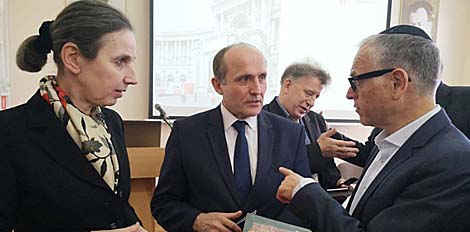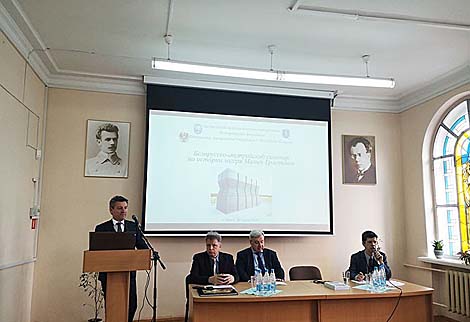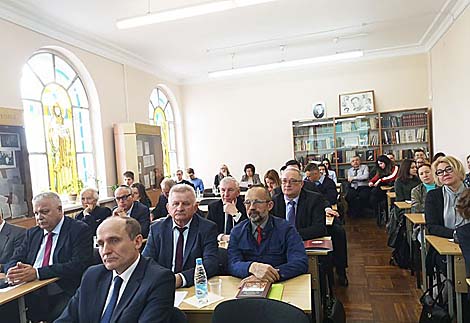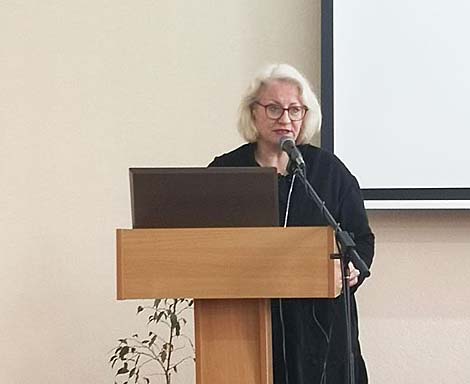Opinions & Interviews
Austrian researchers to continue studying Nazi crimes in Belarusian Trostenets

MINSK, 29 March (BelTA) – Austrian researchers will continue studying Nazi crimes in Belarusian Trostenets, Head of the public association IM-MER Waltraud Barton said as she took part in the Belarus-Austria workshop on the history of the Trostenets death camp on 29 March, BelTA has learned.
Waltraud Barton started to study the tragic history of her mother’s and father’s families several years ago and since then her personal interest has evolved into an international project on commemorating the Nazi victims, including members of her family. Waltraud Barton came to Minsk as a member of the delegation of Austrian Federal Chancellor Sebastian Kurz who together with Belarus’ President Alexander Lukashenko unveiled the monument Array of Names in the memorial complex Trostenets on 28 March. The monument is meant to honor the memory of Austrian victims of Nazism.
 The opening of this monument became possible mainly thanks to several years of hard work of Waltraud Barton and her supporters: descendants of the Nazi victims, representatives of Belarusian and Austrian government bodies and public associations.
The opening of this monument became possible mainly thanks to several years of hard work of Waltraud Barton and her supporters: descendants of the Nazi victims, representatives of Belarusian and Austrian government bodies and public associations.
 According to Waltraud Barton, her work is based on the emotional connection with the Trostenets tragedy. The work consists of two parts: collection of historical information and visits to Belarus. “We come here to learn about the life of Austrian Jews and Belarusians who died here. Trips to Trostenets unite the descendants of the victims and those who committed Nazi crimes as well as people who want to combat Nazism today,” Waltraud Barton said. “We bring nameplates of those who died here and hang them in Trostenets, make arrangements for a memorial service the next day. This is how we bring back the names of the Austrians who died here,” she added.
According to Waltraud Barton, her work is based on the emotional connection with the Trostenets tragedy. The work consists of two parts: collection of historical information and visits to Belarus. “We come here to learn about the life of Austrian Jews and Belarusians who died here. Trips to Trostenets unite the descendants of the victims and those who committed Nazi crimes as well as people who want to combat Nazism today,” Waltraud Barton said. “We bring nameplates of those who died here and hang them in Trostenets, make arrangements for a memorial service the next day. This is how we bring back the names of the Austrians who died here,” she added.
 The association also organizes events to restore the memory of the Nazi victims in Vienna. While events in Trostenets commemorate each victim, Vienna events commemorate the Nazi victims in general. “We go through the streets of Vienna in a mourning march, read out the names of the victims, one thousand at a time. Because that is how many people were carried away in every echelon from Vienna to the death camp to be killed right away,” Waltraud Barton said.
The association also organizes events to restore the memory of the Nazi victims in Vienna. While events in Trostenets commemorate each victim, Vienna events commemorate the Nazi victims in general. “We go through the streets of Vienna in a mourning march, read out the names of the victims, one thousand at a time. Because that is how many people were carried away in every echelon from Vienna to the death camp to be killed right away,” Waltraud Barton said.
Director General of the Arts and Culture Division of the Federal Chancellery of Austria Jurgen Meindl believes that the opening of the monument Array of Names will lay a foundation for large-scale research work on Trostenets.
Taking part in the workshop were also representatives of the History Department of Belarusian State University (BSU), the Institute of History of the National Academy of Sciences of Belarus, the House of Austrian History, the Documentation Center of Austrian Resistance, the Austrian Science Fund. The workshop was organized by the BSU History Department in cooperation with the Austrian embassy in Belarus.







 print version
print version make home page
make home page add to bookmarks
add to bookmarks

